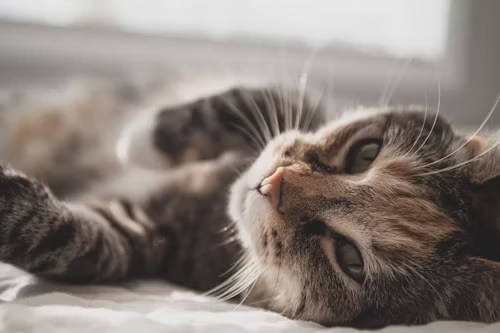Introduction
Cats are naturally curious and playful creatures who thrive on mental and physical stimulation. While there are many store-bought toys available, creating DIY enrichment projects can be a fun and cost-effective way to keep your feline friend entertained. In this blog, we’ll explore a variety of creative DIY projects designed to engage and enrich your cat’s life.
1. Interactive Puzzle Toys
Interactive puzzle toys are excellent for stimulating your cat’s mind and keeping them occupied.
a. Cardboard Box Puzzle
- Materials: Cardboard box, scissors, cat treats.
- Instructions: Cut small holes or slits into a cardboard box, just large enough for your cat’s paw to reach through. Hide treats inside the box and let your cat figure out how to get them.
- Benefits: Encourages problem-solving and provides mental stimulation.
b. Toilet Paper Roll Toys
- Materials: Empty toilet paper rolls, treats or kibble.
- Instructions: Fold the ends of the roll to seal it, and place treats or kibble inside. Let your cat roll and bat the tube to get the treats out.
- Benefits: Easy to make, and provides both mental and physical stimulation.
2. Climbing and Scratching Projects
Cats need vertical space to climb and scratch, which helps them stay physically active and satisfied.
a. DIY Cat Tree
- Materials: Wood planks, sisal rope, carpet scraps, glue, screws.
- Instructions: Assemble wooden planks into a multi-level cat tree, covering the surfaces with carpet scraps and wrapping scratching posts with sisal rope.
- Benefits: Provides climbing opportunities, scratching posts, and resting areas.
b. Scratching Post
- Materials: Cardboard, glue, a sturdy base.
- Instructions: Glue layers of cardboard together and wrap around a sturdy base. Your cat can scratch and shred the cardboard.
- Benefits: Satisfies scratching instincts and helps keep your cat’s claws healthy.
3. Sensory Enrichment
Enhance your cat’s sensory experience with DIY projects that stimulate their senses.
a. Catnip Toys
- Materials: Fabric, catnip, needle and thread, stuffing.
- Instructions: Sew small fabric pouches, fill them with catnip, and stitch them closed. You can also add a little stuffing for extra fun.
- Benefits: Provides excitement and mental stimulation, as many cats are attracted to catnip.
b. Crinkle Balls
- Materials: Aluminum foil, tape.
- Instructions: Crumple aluminum foil into a ball and secure with tape. The crinkling sound and movement will attract your cat’s attention.
- Benefits: Stimulates your cat’s sense of hearing and sight.
4. Interactive Games
Engage your cat with fun and interactive games that you can create at home.
a. Feather Wand
- Materials: Craft stick or dowel, string, feathers.
- Instructions: Attach feathers to one end of a string, and then tie the string to the craft stick or dowel. Move the wand around for your cat to chase.
- Benefits: Encourages exercise and stimulates your cat’s hunting instincts.
b. Laser Pointer Game
- Materials: Laser pointer.
- Instructions: Use a laser pointer to create a moving light that your cat can chase. Always end the game with a tangible toy to catch.
- Benefits: Provides high-energy exercise and mental stimulation.
5. Comfort and Hideaways
Creating cozy and secure spaces for your cat can also be an enriching experience.
a. DIY Cat Bed
- Materials: Old sweatshirt or blanket, needle and thread, stuffing.
- Instructions: Sew or tie a blanket or old sweatshirt into a cozy bed, and fill it with stuffing or a soft pillow.
- Benefits: Provides a comfortable resting spot that smells like you, which can be soothing for your cat.
b. Cat Hideaway
- Materials: Cardboard boxes or fabric, scissors, glue.
- Instructions: Create a hideaway by cutting holes and assembling boxes into a small hideout. You can also use fabric to make a hanging tent.
- Benefits: Offers a private space for your cat to retreat and relax.
6. Food-Dispensing Toys
Making mealtime interactive can add enrichment to your cat’s diet.
a. DIY Puzzle Feeder
- Materials: Plastic bottle, scissors.
- Instructions: Cut holes in a plastic bottle and fill it with your cat’s kibble. Your cat will need to roll the bottle to get the food out.
- Benefits: Slows down eating and provides mental stimulation.
b. Egg Carton Feeder
- Materials: Empty egg carton, treats or kibble.
- Instructions: Place treats or kibble in the compartments of an egg carton and fold the carton to close it. Let your cat figure out how to get the treats.
- Benefits: Encourages problem-solving and provides a fun mealtime challenge.
7. Interactive Activities
Sometimes, simple interactions can provide great enrichment for your cat.
a. Hide and Seek with Treats
- Materials: Treats, hiding spots.
- Instructions: Hide treats around the house and encourage your cat to find them.
- Benefits: Stimulates your cat’s sense of smell and keeps them active.
b. Paper Bag Fun
- Materials: Paper bags.
- Instructions: Place a paper bag on the floor and let your cat explore it. You can also crinkle the bag to add more intrigue.
- Benefits: Provides a new texture and a place for your cat to explore and play.
8. Enrichment for Different Cat Types
Tailor enrichment activities to suit your cat’s individual needs and preferences:
a. Active Cats
- Description: For high-energy cats, incorporate more physically stimulating toys and activities.
- Examples: Laser pointers, feather wands, climbing structures.
b. Calm Cats
- Description: For more relaxed cats, focus on sensory enrichment and comfort.
- Examples: Catnip toys, cozy beds, gentle interactive games.
Conclusion
DIY cat enrichment projects are a fantastic way to keep your feline friend entertained and mentally stimulated. From interactive puzzle toys and climbing structures to sensory enrichment and cozy hideaways, there are countless creative ways to engage your cat. By incorporating these projects into your cat’s daily routine, you’ll provide them with the mental and physical stimulation they need to stay happy and healthy.











Leave a Reply